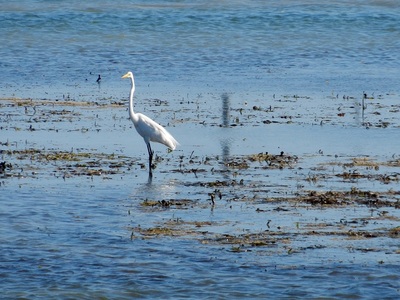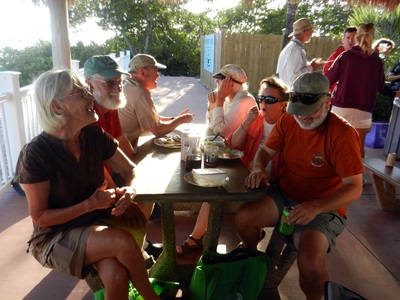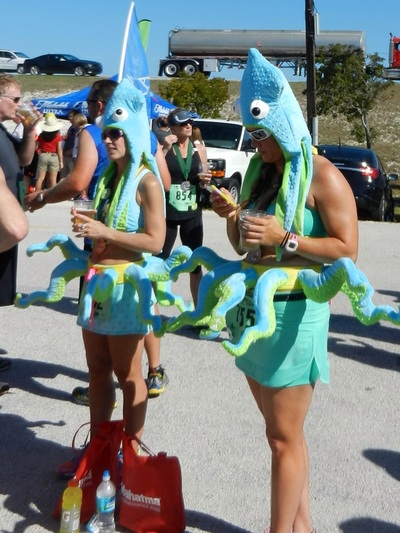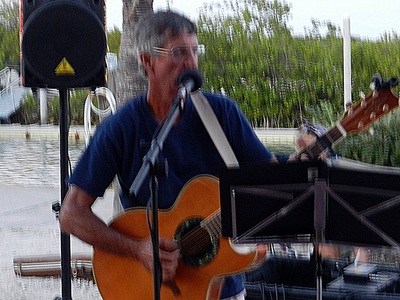 The mooring field next to us starts to look pretty empty.
The mooring field next to us starts to look pretty empty. If we were more superstitious, the occurrence of a blood moon the night before we left on our first trip with Jr under tow, might have given us pause. A bad omen, or something like that. Instead, we simply ignored the heavenly warnings and plowed ahead. Our last 2 weeks in Marathon were busy with lots of prep tasks for packing Orion Jr up on her trailer and heading out for the road trip north, the most anticipated being the lowering of the mast. By mid-month, she was sitting on the trailer, (pretty much) ready to move and we pulled into the traffic on US 1 to leave the Keys behind for the season.

A Lever Long Enough . . .
It was an event almost 3 years in the making. After the near-disaster of raising the mast back in Mayo, MD when we first bought Jr, we were determined to have a process that was more under control. As we described in our last post, Dave had designed a gin-pole (essentially a big lever) that could be used to control the mast's descent (and eventually its ascent). Early in the morning, a couple of days before departing, the time had come to put it to use.
It was an event almost 3 years in the making. After the near-disaster of raising the mast back in Mayo, MD when we first bought Jr, we were determined to have a process that was more under control. As we described in our last post, Dave had designed a gin-pole (essentially a big lever) that could be used to control the mast's descent (and eventually its ascent). Early in the morning, a couple of days before departing, the time had come to put it to use.
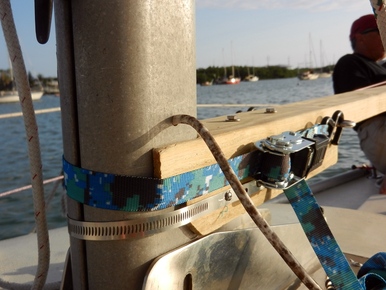
We had debated whether to lower the mast with Jr in the water, or to wait until she was on land. Lowering in the water had the advantage of putting the boat in more "road ready" state, but there was a risk that if something went wrong, the mast or some part of the rigging could slide into the water. If, on the other hand, we waited for it to be hauled, we would have less control over the wind conditions that we would encounter. It would also delay a number of prep tasks until the last day, when we would be scrambling to finish up and leave. So, we opted to do it in the water.

But first things first. To start with, we needed to turn off the freezer.
So, how did we get to talking about the freezer, when this section is about lowering the mast? It's a little convoluted, but it does make sense. Before rigging the gin pole, we need to get some of the boat's on-deck hardware out of the way. This includes the sails and the bimini. We grabbed a brief lull in a very windy week to lower the headsail. Next we took down the mainsail and the boom with the stackpack wrapped around it. (That made sleeping down below more challenging, to say the least.) Despite the increasing heat and intense sunlight of early April, we had to remove the bimini and lash the bows to the deck so they would be secure for the road. With the bimini down, the solar panels were down as well, so we would have less charging capacity. That meant the freezer had to be turned off. (Did you follow that logic?)
So, how did we get to talking about the freezer, when this section is about lowering the mast? It's a little convoluted, but it does make sense. Before rigging the gin pole, we need to get some of the boat's on-deck hardware out of the way. This includes the sails and the bimini. We grabbed a brief lull in a very windy week to lower the headsail. Next we took down the mainsail and the boom with the stackpack wrapped around it. (That made sleeping down below more challenging, to say the least.) Despite the increasing heat and intense sunlight of early April, we had to remove the bimini and lash the bows to the deck so they would be secure for the road. With the bimini down, the solar panels were down as well, so we would have less charging capacity. That meant the freezer had to be turned off. (Did you follow that logic?)
 Pulley system under bow end of gin pole
Pulley system under bow end of gin pole On the morning of the mast-lowering, we were up early to take advantage of the calmer conditions for the day. We had a friend, Rick on Forever, coming to help at 8:30, but we needed to rig the gin-pole first, along with the temporary shrouds and the block and tackle. Everything had a a back-up. The gin pole was attached to the mast with both ratchet straps and a hose clamp. Of the three sets of shrouds holding the mast side-to-side, we were only removing the forward pair. Their function would be taken over by a set of temporary shrouds that Dave had made out of polypropylene line, attached by clips to the mast about 7 feet up from the deck. The gin pole was also held centered by a similar set of "shrouds" attached to the toe rail and the bow end of the pole. To control the actual lowering, a set of pulleys was clipped into the bottom of the bow end of the gin pole. This was backed up by a line that was originally a spare halyard from Orion, run through the blocks for that normally hold the jib sheets.
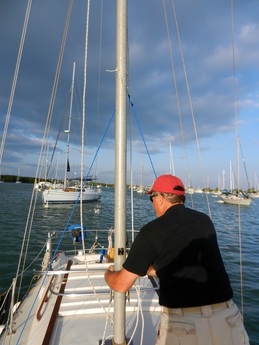 David rigging temporary shrouds
David rigging temporary shrouds With all of the new rigging in place, we were finally ready to take the leap. Dave disconnected the CDI furler fromthe foredeck. With Dave positioned at the bow to control the primary lines, Rick at the base of the mast, to watch for any problems there and to guide the mast down, if necessary, and Cathy in the cockpit to tail the secondary control line, we were ready to start lowering. The mast came down so easily, that we lowered and raised and then lowered it again, just to convince ourselves we could do it so effortlessly.
 Rick next to the mast
Rick next to the mast Once the mast was down, we had a couple of unforeseen problems. The first was that the gin pole was so tightly connected to its shrouds and these were connected so high up (~ 8.5 ft above deck), that we couldn't release the gin pole from the mast. After considering various alternatives, we decided to just cut one of the lines. This relieved the pressure and the remaing lines could be unclipped and removed. With the gin pole off the mast, we turned our attention to disconnecting the mast from its tabernacle. It was putting a lot of pressure on the forward bimini bows. We relieved this pressure temporarily with a block of wood. Now, with Rick positioned in the cockpit by the mast, Dave worked to remove the pin holding the mast in the tabernacle. The pressure made it hard to remove, but when it did, the top of the mast dunked in the water. With Rick's quick action, we managed to keep it on the boat. (Note to self: Secure mast to boat before taking pin out of tabernacle.) Whew!
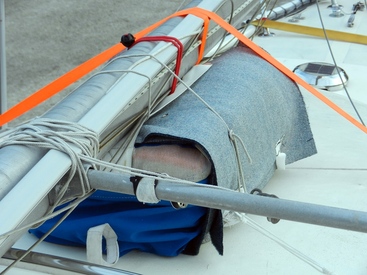 Supporting the center of the mast
Supporting the center of the mast We moved the mast forward so it was more balanced. Then Dave lashed a boat hook to the bottom of the mast to support the longer furler that would be secured to it. Several lines and ratchet straps later and the mast was firmly secured to the boat. The final steps were to support the center of the mast with several life jackets from the dinghy covered in some carpet for chafe protection. Using the same carpet and some blocks of wood, we protected the bimini bows from the mast and each other. It was a relief to finally have this worrisome task behind us with some confidence that doing it a second time wouldn't be so bad.

Back to Land
The day had finally arrived. We had an 11am appointment at the haul-out slip, but we arrived early to tie up to the wall nearby at Marathon Marina and Boatyard. We needed to finish cleaning and dismantling the dinghy. We also wanted to remove the dinghy outboard while it was easier to do. As Jr came out of the water, it was a study in contrasts. Dave's weekly bottom cleanings had kept the bottom up to the keel clean. However, the keel, which was beyond his reach, was really bad. As the Travel Lift operator cleaned off this growth, the trailer arrived and Jim from South Seas Rigging began making adjustments to the supports to fit the boat.
The day had finally arrived. We had an 11am appointment at the haul-out slip, but we arrived early to tie up to the wall nearby at Marathon Marina and Boatyard. We needed to finish cleaning and dismantling the dinghy. We also wanted to remove the dinghy outboard while it was easier to do. As Jr came out of the water, it was a study in contrasts. Dave's weekly bottom cleanings had kept the bottom up to the keel clean. However, the keel, which was beyond his reach, was really bad. As the Travel Lift operator cleaned off this growth, the trailer arrived and Jim from South Seas Rigging began making adjustments to the supports to fit the boat.

It took about an hour, but the lift operator finally figured out how to get his slings out from under the boat, while maintaining its balance, despite the fact that the trailer supports were not yet fitted to the hull. Using a forklift to support the stern, and some blocks of wood under the keel, he managed to transition the weight to the trailer. Then Dave and Jim took over adjusting the supports to align to the hull. Working under a hot noonday sun, they made the adjustments until the boat supports were where they needed to be. After a lunch break, we strapped the boat to the trailer so that it was secure. Finally, we attached the trailer to the truck and we were left on our own to finish getting the boat ready to move.

Over the next several hours, we secured the dinghy, the rudder, and the gin pole beneath the trailer. Then we moved up to the cockpit, removing the outboard, tiller, grill, etc. And stowing them wherever it made sense. Finally, we secured everything below decks for a road trip. We had been planning for this for months, se we thought we had everything we needed to get underway. We had a Florida temporary title and license, insurance, straps to secure the boat to the trailer, a trailer lock, even tire covers. We had tested the truck brake controller and wiring to ensure it was sending signal back to the trailer lights and brakes.
But we weren't quite as prepared as we hoped. Since Orion Jr extends more than 4 feet beyond the end of the trailer, we needed to put flags on the stern and the end of the mast. In addition, we needed lights and reflectors for traveling at night. The trailer tires needed air. We needed chocks for the wheels . Oh, and did we mention that the trailer brakes weren't activated by the truck's brake controller. It was getting late when we packed up, showered and headed out to find what we could use for flags, reflectors, a trailer pin and chocks. The brakes would wait have to wait until morning.
We called it a day and enjoyed some dinner at Keys Fisheries, sitting by the Florida Bay and eating our last lobster of the season. Tomorrow would be soon enough to deal with all of these issues. Most of them were resolved once we got to Daytona. We found reflectors at Harbor Freight and strips of 12V LED lights at Wal-mart. Cathy made flags for the stern, And the problem with the brake controller turned out to be a blown fuse. All was well for the trip further north.
But we weren't quite as prepared as we hoped. Since Orion Jr extends more than 4 feet beyond the end of the trailer, we needed to put flags on the stern and the end of the mast. In addition, we needed lights and reflectors for traveling at night. The trailer tires needed air. We needed chocks for the wheels . Oh, and did we mention that the trailer brakes weren't activated by the truck's brake controller. It was getting late when we packed up, showered and headed out to find what we could use for flags, reflectors, a trailer pin and chocks. The brakes would wait have to wait until morning.
We called it a day and enjoyed some dinner at Keys Fisheries, sitting by the Florida Bay and eating our last lobster of the season. Tomorrow would be soon enough to deal with all of these issues. Most of them were resolved once we got to Daytona. We found reflectors at Harbor Freight and strips of 12V LED lights at Wal-mart. Cathy made flags for the stern, And the problem with the brake controller turned out to be a blown fuse. All was well for the trip further north.

Final Days in Marathon
It's the latest we've stayed in Marathon, but we were rewarded with some absolutely beautiful weather. It continued to be cool at night and the breezes were warm and pleasant. We spent more evenings listening to great music at the marina's Tiki hut, escorted Captain Jack to the SSCA lunch at Hurricane and continued to get more involved at church, even leading a service one Sunday. Rick and Pam from Forever were interested in learning more about our solar panels, battery monitor and overall battery charging system. We enjoyed spending time together with them. And, of course, Rick saved our mast.
But one of the most memorable events took place on our last night. Unable to sleep, Cathy looked around at what should have been a night illumined by a full moon. However, the moon was only a crescent. The Lunar Eclipse was well under way. While we watched for the next half hour, the crescent slipped from view and the moon began to glow red. A blood moon. The clear sky and a gentle breeze made it a perfect night to watch this amazing celestial event. Not a bad omen at all. Just the beginning of a new chapter.
It's the latest we've stayed in Marathon, but we were rewarded with some absolutely beautiful weather. It continued to be cool at night and the breezes were warm and pleasant. We spent more evenings listening to great music at the marina's Tiki hut, escorted Captain Jack to the SSCA lunch at Hurricane and continued to get more involved at church, even leading a service one Sunday. Rick and Pam from Forever were interested in learning more about our solar panels, battery monitor and overall battery charging system. We enjoyed spending time together with them. And, of course, Rick saved our mast.
But one of the most memorable events took place on our last night. Unable to sleep, Cathy looked around at what should have been a night illumined by a full moon. However, the moon was only a crescent. The Lunar Eclipse was well under way. While we watched for the next half hour, the crescent slipped from view and the moon began to glow red. A blood moon. The clear sky and a gentle breeze made it a perfect night to watch this amazing celestial event. Not a bad omen at all. Just the beginning of a new chapter.
